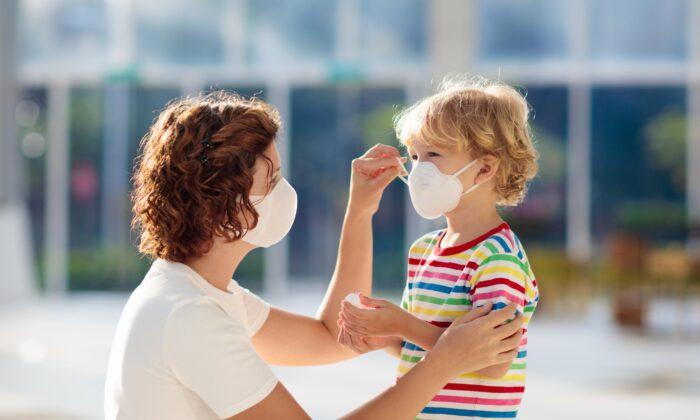If 2020 could be summed up in a single garment, it would be a mask.
Whether it’s one of those blue pleated surgical models, a snug-fitting N95, or a homemade version with a cheery seasonal print, the mask has become the face of the pandemic. There are several ways doctors say we can protect ourselves from COVID-19, but the loudest and most persistent prescription by far is a mask.
Wearing a mask is supposed to contain a potentially deadly disease. And with no end in sight for the COVID-19 pandemic, health officials want to see more masks on more faces.
Of course, not everyone embraces the idea. Masks are uncomfortable, inconvenient, and some evidence suggests they might be unnecessary. However, in many indoor places, masks are a requirement. And as case numbers continue to climb, many call for a mandate in which everyone must mask up anywhere they go.
“Under different outbreak scenarios and mask usages, the researchers calculated the total numbers of expected SARS-CoV-2 infections and deaths from COVID-19,” Collins said. “Not surprisingly, they found that the total number of deaths and infections declined as the availability and effectiveness of face masks increased.”
In their last installment, researchers concluded that due to the extensive risk to mask wearers documented in these papers, “we urgently recommend that no adult or child be coerced to wear a mask under any circumstances.”
In a world in which people consider a mask a life-or-death issue, such a statement seems dangerous, blasphemous, and anti-science.
But according to co-author of the papers on the problems associated with masks, Dr. Colleen Huber, forcing everyone to mask up doesn’t make sense.
“Respiratory droplets have been really exaggerated recently by those who advocate masks. As if we were spitting all over everything all the time,” Huber said. “It suggests we’ve been lethal to human success of the species. However, for 99.999 percent of our existence on earth, we’ve been a relatively successful species from an evolutionary perspective.”
While Huber’s statement may sound radical in a discussion of mask mandates, many doctors and scientists back her claim.
“For instance, there is no randomized evidence to show that mask mandates would work to slow the spread of the disease. In fact, for influenza, the randomized studies that have been done suggest that they don’t work to slow the spread of the disease.”
Huber and her team observed a similar theme in regard to COVID-19. They looked at data from a survey on masks done by the Council on Foreign Relations (CFR) this summer, and compared it to their own survey with the same 25 countries three months later.
Both surveys asked subjects if they had always worn a mask when they left their homes. In the CFR survey, Singapore had the highest yes responses: 93 percent. The fewest were Finland and Denmark, where only 1 percent answered yes.
“When we looked at the same countries in October, there were actually fewer positive COVID tests in the countries that were the least masked,” Huber said.
Danish researchers published their findings in a November issue of the Annals of Internal Medicine. They conducted a randomized controlled study with about 4,800 participants completing the trial. Half the subjects were assigned to wear masks, and the other half went without. Both groups were instructed to maintain other public health measures—social distancing and clean hands.
COVID-19 infections occurred in 42 participants who wore masks (1.8 percent) and in 53 of the maskless control participants (2.1 percent), resulting in a “statistically insignificant” difference of 0.3 of a percentage point.
Stopping the Spread?
It seems hard to believe now, but when the COVID-19 pandemic first hit, health officials actually discouraged people from wearing masks. On March 30, a United Nations tweet, citing experts from the World Health Organization (WHO), stated that “there is no evidence that wearing a mask by healthy people has any medical benefit.”Today, masks must now be worn everybody, whether you feel sick or not.
The policy changed when health officials discovered that asymptomatic carriers, people actively infected with COVID-19 but showing no symptoms, were inadvertently spreading the disease through the process of normal respiration.
However, health officials remain firm that masks are a must for perhaps years to come. Even with a vaccine, health experts say we must remain diligent in containing our droplets.
In October, Dr. Anthony Fauci, infectious disease expert and head of the U.S. COVID-19 task force, forecast that mask-wearing and social distancing may remain in our world well into 2022.
The mathematical model used to support mask mandates primarily focuses on medical-grade, surgical masks. But anything that covers your mouth and nose will get you in a store without a hassle.
Another issue was noted with N95 masks that feature an exhalation valve. Researchers said the valve doesn’t compromise the protection of the wearer, but it “can decrease the protection of persons surrounding the wearer.”
The Duke University study also found that bandanas and knitted masks also performed poorly, but none of these findings have done anything to change health policy.
Huber says there’s a concerted effort to censor any negative information about masks, even if the details might be important to public health.
“Those blue masks available at the grocery store, they’re sterilized with ethylene oxide, which is a known carcinogen. And they are made with PFOA in their fibers which is a known lung cancer risk,” Huber said. “I retweeted this on Twitter and I was kicked off for seven days.”
Weighing the Risks
Throughout the pandemic, YouTube and social media have routinely silenced voices that stray from official statements and policy pertaining to COVID-19, or attached warning labels to give context to rogue commentary.“We’re not just battling the virus,” said WHO Director-General Tedros Adhanom Ghebreyesus. “We’re also battling the trolls and conspiracy theorists that push misinformation and undermine the outbreak response.”
For example, if masks truly save lives, then any information that might discourage the public from wearing one could prove deadly.
However, if there are health problems associated with masks, shouldn’t this also inform policy?
In Huber’s studies, and in several she cited, masks compromise oxygen intake. They may be made of thin cloth, but a physical barrier is still covering your airways, and breathing is clearly better without one.
“There is no successful species that has any obstruction to their breathing,” Huber said. “No species has evolved a mask, chosen to wear one, or sought out a mask in nature. It’s only humans and this has been very rare throughout our history, for free people anyway. Masks have been used historically in slavery, and in torture at Guantanamo.”
Of course, surgeons regularly wear masks for hours on end, so we should theoretically have little problem with one when we go about our business. However, there is evidence that even medical personnel can have issues.
Since 1979, the U.S. Occupational Safety and Health Administration (OSHA) has determined that the optimal range of oxygen in the air for humans is 19.5 percent or more. Anything less has been labeled as “not safe for workers.”
When Huber and her team measured the airspace inside a mask with an OSHA-approved oxygen meter, it measured 17.4 percent within 10 seconds, and stayed below that threshold.
Children under 2 years of age are exempt from mask regulations, but Huber and her colleagues believe older children should also be exempt. They note that oxygen deficiency is even more of an emergency for younger people than it is for adults. They point to anatomical differences in children’s bodies that make them more vulnerable to “injury from hypoxic assault.”
Another issue with mask-wearing is particulates. Huber and her team looked at brand-new masks of the models most frequently worn, and at 40 times magnification found lots of debris and loose fibers all over the face-side surface. The most debris was found on cloth masks that had been laundered once.
Inhaling a few particulates may seem fairly harmless. But Huber found numerous air-quality issues that exist inside a mask compared to barrier-free breathing. And over time, these issues could lead to serious illness.
“If you inhale particulates, then you put yourself at risk for lung diseases,” Huber said. “One of the worst diseases that we mention that is a risk is pulmonary fibrosis. It’s a very threatening disease because there is no cure for it in conventional or natural medicine. Pulmonary fibrosis is slow suffocation of a patient. The survival rate at five years is only 20 percent.”
Because a mask deprives you of oxygen, you have to breathe more forcefully to get the air you need, which results in more suction, drawing in debris.
Our bodies are designed to cough out most particulates we might happen to inhale, thanks to little hair-like structures in our upper airways called cilia that help us expectorate. However, because a mask makes it harder to expel carbon dioxide, Huber says it can make cilia immobile, and keep particles stuck deep in our airways.
It’s clear that good breathing is essential to good health. We inhale life-giving oxygen and exhale carbon dioxide waste with every breath. But Huber says that for all types of masks, the carbon dioxide in the masked airspace exceeded the OSHA requirement for room air in about 30 seconds, and continued to increase the longer it is worn.
“People might say, ‘Carbon dioxide molecules are so tiny, even tinier than a virus that it can easily escape through the mesh of a mask,’” Huber said. “This isn’t true. While it only takes a microscopic amount of viral particles to infect, we breathe out about a half liter to a liter of carbon dioxide with every single breath. ... That’s a lot of carbon dioxide.”
Meehan estimates having worn a medical mask in surgical procedures more than 10,000 times, but he says even those who wear masks properly in an operating room, an environment designed for people to wear masks in for prolonged periods of time, suffer health problems from wearing them.
“I'll start to develop a tremor after 30 minutes of mask wear in that high air-exchange, higher oxygen level, cool environment [of the operating room]. Imagine what untrained members of our community are doing when they are wearing them in the Oklahoma summer.” he said. “Masks can block oxygen intake significantly. That’s been demonstrated in experiments all over the world. It’s been studied in surgeons in an optimal environment where there is a higher level of oxygen in an operating suite.”
As case levels rise, and officials struggle to get a pandemic under control, many look to mask mandates as part of the solution. But should a cost-benefit analysis of a mass medical intervention also be included in the conversation? Huber believes so. She says that understanding the harms is especially urgent for children, employees, and others compelled to wear a mask for extended periods of time.
“People think, ‘Well, it’s just a piece of cloth. I’m just going to wear it for a few minutes while I go to the grocery store. What’s the big deal if it protects Grandma?“’ Huber said. “But at what point does the illness that results from this going to be regrettable?”







Friends Read Free